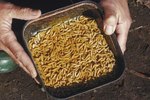Bird seed for pet birds or wild birds should always be stored in an airtight container to prevent bug infestation. When purchasing bird seed in bulk form from feed stores or pet stores always check the seed for any bug infestations, larvae or webbing. There are several bug varieties that can infest bird seed. These pests can also travel from bird seed into flour, grains and foods in the home pantry. Any bird seed that is found to be infested with bugs should be promptly disposed of.
Granary and Rice Weevils
Granary and rice weevils are also commonly called 'snout weevils'. These bug pests will penetrate whole grains in the larvae stage. Infestation often first occurs in the grain storage facilities before the seed is ever processed into bird food. The processing plants themselves can often be a source of infestation. Granary and rice weevils are harmless to humans. They do not bite or sting but any food that is infested should be promptly thrown out. Granary and rice weevils will commonly move from the bird seed into any beans stored in the home pantry. The larvae feed inside the grain and are usually never visually seen. Infestation is suspected when the adult weevils exit the grain through tiny holes. Use a flashlight to exam bird seed closely for any adults.
Indian Meal Moth
Indian meal moth infestation in bird seed can be detected by looking closely for the fine silk webbing that the moths spin in the feed. The Indian meal moth will quickly spread to your kitchen pantry. They will easily infest powdered milk, cornmeal, flour, dried fruits, graham crackers, pasta and even pet food. The moths will fly around under the cover of darkness. The moths will lay their eggs in the food and the larvae will readily consume the food before turning into moths. The larvae are tiny worms with black heads. They will often leave the food and climb walls where homeowners will find them suspended on silken webs. Infestation can occur in stores, feed companies, manufacturers and many locations. Promptly throw away any bird food suspected of containing the Indian meal moths or the larvae of the Indian meal moth.
Maize Weevil
The maize weevil is quite common in bird seeds. Adult beetles are reddish brown or black in color with a long snout. Tiny spots of red often appear on the weevils back. They easily infest bird seed at the processing factories or in pet stores. The larvae consume the bird seed. Use a flashlight to look for maize weevil infestation. Promptly throw away any bird seed contaminated with the weevils. Maize weevils will infest cornmeal and beans in the home pantry.
Cigarette Beetle
The cigarette beetle adores tobacco products but will also feed on seeds, upholstery, pasta, dried flowers, bird seed and cereal products. They are a common pests along the Atlantic Coast and in the Gulf Coast states. Any bird seed that is found to be infested with the cigarette beetle needs to be promptly thrown away before the beetles take over the entire household and the infestation becomes widespread. The adults are tiny and oval in shape. They enjoy flying when the light is low.
References
Photo Credits
-
Jupiterimages/liquidlibrary/Getty Images
Writer Bio
Based in Oregon, Kimberly Sharpe has been a writer since 2006. She writes for numerous online publications. Her writing has a strong focus on home improvement, gardening, parenting, pets and travel. She has traveled extensively to such places as India and Sri Lanka to widen and enhance her writing and knowledge base.




